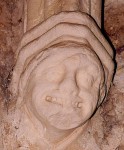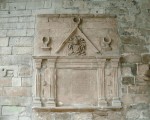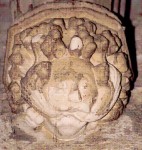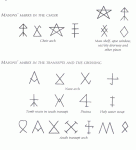Seton Collegiate Church
- Seton Collegiate Church from the south
- The Murdered Apprentice
- Grotesque Face
- Ogilvie Monument
- Peacock
- Seaton Graveslab – Masons Tools
- Graveslab
- Another Green Man
- Another Masons’ Mark
- Masons’ Mark
- Angel
- Exterior Cornice
- Another Green Man
- Anonymous Graveslab
- Cross with Fleur de lis
- A strange face
- The Choir from the west – looking east
- Happy Face
- Getting to Seaton Collegiate Church
- Lady Janet Seton
- Information Plaque outside the church
- The Perth Monument
- The Masons Marks within Seaton Collegiate Church
- Seaton Green Man
- Christ as symbol – south wall of Seton Collegiate Church
Seton Collegiate Church is situated in a small secluded walled park off the A198 a few miles east of Edinburgh. It is a real pleasure to find such ‘hidden gems’ which, in their own way can rival Rosslyn Chapel (more correctly ‘Church’) for their history, interest and mystery. They are not so ‘in your face’ as is Rosslyn and, therefore, these ‘gems’ take a little more work to appreciate. Such work can lead to a deeper understanding of Scottish history and culture and in so doing one can put Rosslyn Chapel, and other collegiate churches, into historical perspective.
Seton Church, like Rosslyn, was established as a Collegiate Church, to serve a needs of a powerful family and like Rosslyn it too remains unfinished.
Collegiate Churches were established for a number of reasons, for instance:
- As centres of learning (especially law)
- As places for the study of Theology
- As establishments given over to prayers for the souls of members of a particular family in perpetuity
The reasons, above, for building collegiate churches was not mutually exclusive and there were establishments created for other purposes but which included one, or more, of the above mentioned activities.
Seton, like Rosslyn, was devoted principally to one purpose only – the saying of prayers for the soul of the founder of the edifice. In the case of the Rosslyn this was William, Earl of Orkney (c.1400 – c.1484), and his immediate family. Prayers for the souls of his predecessors, and descendants, were also to be included in this arrangement.
Seton Collegiate Church was begun in 1470 but it is thought that there was a parish church on the site from as early as 1242. This church was probably of a simple rectangular design. Lady Katherine St Clair, who had married Lord John Seton, built a side chapel (on the south side) to hold his tomb and an altar at which prayers and masses were offered for his soul. Unfortunately, the side chapel no longer exists although fragments can still be identified. The Grandson of John and Katherine, George, Lord Seton, founded a college of priests to pray for his soul and those of ancestors and family. George began the building of the ‘Magnificent Choir’ – an addition to the east of the existing structure. To the north of the choir he built a sacristy – used by priests to make the necessary arrangements for masses etc. He died in 1478 ‘… in the place of the Blak freires of Edinburgh queir he lyis in the queir of the samin.’ (This is an example of Middle Scots – Ed.) Pope Paul II had granted a mandate c.1471 for the church to be erected into a collegiate church but this does not appear to have been acted upon.
The son of George, also George, was educated in Paris and St Andrews. He obtained official sanction to erect the church into a collegiate church from Pope Alexander VI in 1492. The church was dedicated to St Mary and the Holy Cross. The college comprised of a Provost, six Priests, a Clerk together with two choir boys. George was described as a man ‘… of cunning in astrology, theology and music.’ He completed the work begun by his father by vaulting the choir and sacristy.
The third Lord Seton (also thought to be named George) completed the work began by his grandfather and progressed by his father. He specifically finished the choir and installed the furnishings. He also built the homes of the priests some foundations of which can still be viewed to the south west of the church. This Seton died about 1508.
Lady Janet Seton, nee Hepburn, built the north transept soon after her husband’s death at the Battle of Flodden (1513).
During the ‘Rough Wooing’ (1543-1547) in 1544 the Earl of Hereford, at the behest of Henry V, laid waste to large parts of southern Scotland. This was an attempt to force the Scots to have their Queen Mary (then six months old) marry Edward, Henry’s heir, then age six years. The terms of the marriage agreement were considered too onerous by the Scots as it ensured the negation of the ‘Auld Alliance’ with the French and subjugated much Scottish independence, the ‘Rough Wooing’ attempted to impose, by force, the desires of the English. The devastation of 1544 was repeated in 1545 and 1547.
In the course of the ‘Rough Wooing’, Seton and Rosslyn Churches, like many others, suffered. The bell and organ of Seton Collegiate Church were stolen by Hertford’s forces and parts of the church were burned. The theft of the bell ensured that the faithful could no longer be called to prayer and even if they did attend at the correct time their songs of praise could not be accompanied by organ music.
Lady Janet, demolished Lady Katherine’s side chapel and on the site, a little to the east, she erected the existing south transept. Lady Janet was therefore a significant builder erecting both north and south transepts as well as the tower. The latter is incomplete and it seems that this was a consequence of her death in 1558. This has echoes of Rosslyn in that the vision of one individual is not progressed by the heir.
At the Scottish Reformation (1559-1560) the mother faith was abandoned by many, often under duress. Seton Collegiate Church could no longer be used for its original purpose and masses for the souls of members of the Seton family ceased.
The church was used for a short time as a parish church and a bell, cast in Holland in 1577, was made for the incomplete steeple. Seton was amalgamated with Tranent in 1580 and the church ceased to be actively used as a church and became little more that a private chapel for the members of the Seton family. About 1688 a mob damage the church by smashing the windows, defacing memorials and gravestones. Many items not of religious nature but which were valuable were stolen. This was also the experience of Rosslyn which also suffered badly at the hands of a mob during the ‘Glorious Revolution.’
The Seton family were Jacobites and their support for the ‘Old Pretender’, James Stuart (1688-1766), led to the church being desecrated in 1715 by the Lothian Militia. Many of the remaining funerary monuments were further defaced and on this occasions the mob and undisciplined soldiers broke into graves and coffins looking for ‘hidden treasure’.
This was the final blow and the church was rarely ever used again as a place of worship. The estate of the Setons passed to the Earl of Wemyss who partially restored the church and used it for as a burial place of deceased family members.
The Wemyss family granted the church and immediate surroundings to the people of Scotland and is now in the care of Historic Scotland, the Government body in Scotland, which preserves such edifices for the Scottish nation.
The Murdered Apprentice
One of the most interesting aspects of the lore of Seton Collegiate Church is that it like, Rosslyn Collegiate Church, also has a legend of a murdered apprentice. The legend is virtually the same as that at Rosslyn except that it doe not involve a pillar. The story is that the Master Mason in charge of building the church had a major problem erecting the vaulted roof of the nave and went to another church to examine how the vaulted roof there had been erected. It is not known if the church he visited was local or, as in the case of the Rosslyn legend, was somewhere overseas. Given that there were a number of churches in the vicinity with vaulted roofs it seems likely that a long journey was not involved. In the absence of the Master Mason an apprentice had made the mathematical calculations and drawings showing how the vaulted roof could be built. The Master Mason, his pride being badly bruised (not to mention his ruined reputation of as ‘Master’), flew into a rage and hit the apprentice with a mallet killing him on the spot. Unlike Rosslyn there is no evidence that the remaining masons thought it worthwhile commemorating the Master Mason or the Apprentice’s mother with a stone carving but there is a carving of the murdered apprentice (image to follow). The reporter was informed by a local worthy, from Port Seton, that it was believed that the Seton Master Mason was none other than the disgraced Master Mason from Rosslyn Collegiate Church who had not in fact committed suicide after killing the Apprentice there but had moved to Seton in order to design and later build that church the construction of which began in 1470. If this is true, and it is impossible to substantiate, then the fate of
The legend of a murdered apprentice is more common than one might think. There are a number of buildings in the United Kingdom and in other countries with the same or similar legends.
To be continued…



























